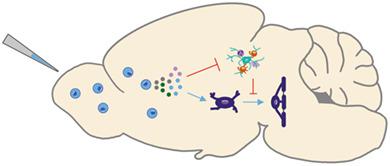Our official English website, www.x-mol.net, welcomes your
feedback! (Note: you will need to create a separate account there.)
Intranasal mesenchymal stem cell therapy to boost myelination after encephalopathy of prematurity
Glia ( IF 5.4 ) Pub Date : 2020-10-12 , DOI: 10.1002/glia.23919 Josine E G Vaes 1, 2 , Caren M van Kammen 1 , Chloe Trayford 3 , Annette van der Toorn 4 , Torben Ruhwedel 5 , Manon J N L Benders 2 , Rick M Dijkhuizen 4 , Wiebke Möbius 5 , Sabine H van Rijt 3 , Cora H Nijboer 1
Glia ( IF 5.4 ) Pub Date : 2020-10-12 , DOI: 10.1002/glia.23919 Josine E G Vaes 1, 2 , Caren M van Kammen 1 , Chloe Trayford 3 , Annette van der Toorn 4 , Torben Ruhwedel 5 , Manon J N L Benders 2 , Rick M Dijkhuizen 4 , Wiebke Möbius 5 , Sabine H van Rijt 3 , Cora H Nijboer 1
Affiliation

|
Encephalopathy of prematurity (EoP) is a common cause of long‐term neurodevelopmental morbidity in extreme preterm infants. Diffuse white matter injury (dWMI) is currently the most commonly observed form of EoP. Impaired maturation of oligodendrocytes (OLs) is the main underlying pathophysiological mechanism. No therapies are currently available to combat dWMI. Intranasal application of mesenchymal stem cells (MSCs) is a promising therapeutic option to boost neuroregeneration after injury. Here, we developed a double‐hit dWMI mouse model and investigated the therapeutic potential of intranasal MSC therapy. Postnatal systemic inflammation and hypoxia‐ischemia led to transient deficits in cortical myelination and OL maturation, functional deficits and neuroinflammation. Intranasal MSCs migrated dispersedly into the injured brain and potently improved myelination and functional outcome, dampened cerebral inflammationand rescued OL maturation after dWMI. Cocultures of MSCs with primary microglia or OLs show that MSCs secrete factors that directly promote OL maturation and dampen neuroinflammation. We show that MSCs adapt their secretome after ex vivo exposure to dWMI milieu and identified several factors including IGF1, EGF, LIF, and IL11 that potently boost OL maturation. Additionally, we showed that MSC‐treated dWMI brains express different levels of these beneficial secreted factors. In conclusion, the combination of postnatal systemic inflammation and hypoxia‐ischemia leads to a pattern of developmental brain abnormalities that mimics the clinical situation. Intranasal delivery of MSCs, that secrete several beneficial factors in situ, is a promising strategy to restore myelination after dWMI and subsequently improve the neurodevelopmental outcome of extreme preterm infants in the future.
中文翻译:

鼻内间充质干细胞治疗促进早产儿脑病后髓鞘形成
早产儿脑病(EoP)是极端早产儿长期神经发育障碍的常见原因。弥漫性白质损伤 (dWMI) 是目前最常见的 EoP 形式。少突胶质细胞(OLs)的成熟受损是主要的潜在病理生理机制。目前没有可用于对抗 dWMI 的疗法。间充质干细胞(MSCs)的鼻内应用是促进损伤后神经再生的一种有前途的治疗选择。在这里,我们开发了一种双重打击 dWMI 小鼠模型,并研究了鼻内 MSC 治疗的治疗潜力。产后全身炎症和缺氧缺血导致皮质髓鞘形成和 OL 成熟的短暂缺陷、功能缺陷和神经炎症。dWMI 后,鼻内 MSCs 分散迁移到受伤的大脑中,有效地改善了髓鞘形成和功能结果,抑制了大脑炎症并挽救了 OL 的成熟。MSCs 与原代小胶质细胞或 OLs 的共培养表明,MSCs 分泌的因子直接促进 OL 成熟和抑制神经炎症。我们表明,MSCs 在离体暴露于 dWMI 环境后会调整其分泌组,并确定了包括 IGF1、EGF、LIF 和 IL11 在内的几个因素,这些因素可以有效促进 OL 成熟。此外,我们发现 MSC 处理的 dWMI 大脑表达不同水平的这些有益分泌因子。总之,产后全身性炎症和缺氧缺血的结合导致了一种模仿临床情况的发育性脑异常模式。MSCs的鼻内递送,
更新日期:2020-10-12
中文翻译:

鼻内间充质干细胞治疗促进早产儿脑病后髓鞘形成
早产儿脑病(EoP)是极端早产儿长期神经发育障碍的常见原因。弥漫性白质损伤 (dWMI) 是目前最常见的 EoP 形式。少突胶质细胞(OLs)的成熟受损是主要的潜在病理生理机制。目前没有可用于对抗 dWMI 的疗法。间充质干细胞(MSCs)的鼻内应用是促进损伤后神经再生的一种有前途的治疗选择。在这里,我们开发了一种双重打击 dWMI 小鼠模型,并研究了鼻内 MSC 治疗的治疗潜力。产后全身炎症和缺氧缺血导致皮质髓鞘形成和 OL 成熟的短暂缺陷、功能缺陷和神经炎症。dWMI 后,鼻内 MSCs 分散迁移到受伤的大脑中,有效地改善了髓鞘形成和功能结果,抑制了大脑炎症并挽救了 OL 的成熟。MSCs 与原代小胶质细胞或 OLs 的共培养表明,MSCs 分泌的因子直接促进 OL 成熟和抑制神经炎症。我们表明,MSCs 在离体暴露于 dWMI 环境后会调整其分泌组,并确定了包括 IGF1、EGF、LIF 和 IL11 在内的几个因素,这些因素可以有效促进 OL 成熟。此外,我们发现 MSC 处理的 dWMI 大脑表达不同水平的这些有益分泌因子。总之,产后全身性炎症和缺氧缺血的结合导致了一种模仿临床情况的发育性脑异常模式。MSCs的鼻内递送,











































 京公网安备 11010802027423号
京公网安备 11010802027423号